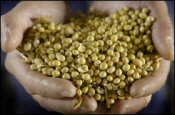



Use Of Biofuels Is Rising
NEW ZEALAND - The extra demand for biofuel should push grain prices higher, making beef produced in feedlots as well as poultry and pork more expensive internationally, says Massey University farm and agribusiness management lecturer Nicola Shadbolt. |
| agricultural products specifically grown for use as biofuels include corn and soybeans |
The price of corn has already doubled as the US moves to a higher percentage of biofuel, to cut its reliance on imported oil.
Biofuel is a renewable energy source, and agricultural products specifically grown for use as biofuels include corn and soybeans, primarily in the United States; flaxseed and rapeseed, primarily in Europe; sugar cane in Brazil; and palm oil in South- East Asia.
"In the US it's a matter of national security, rather than food related. So the money has been found for biofuels. Somewhere around 16 new ethanol (biofuel) plants are being set up in the US every month," Ms Shadbolt says.
It is a country dependent on a huge corn-belt for grain production which is used to feed pigs, poultry and cattle.
Almost all US beef is grain finished in feedlots and grass-fed beef is not much more than 1 percent of the market, a niche described often as natural or organic.
The hope in New Zealand is more expensive grains will mean fewer grain-fed animals and a larger gap for New Zealand grass-fed beef.
Although tiny, grass-fed beef is a growing market sector which South American countries have tapped into, says agricultural business lecturer Daniel Conforte. He is newly arrived at Massey from Uruguay and knows the South American farming and production system well.
Source: Stuff.co.nz








